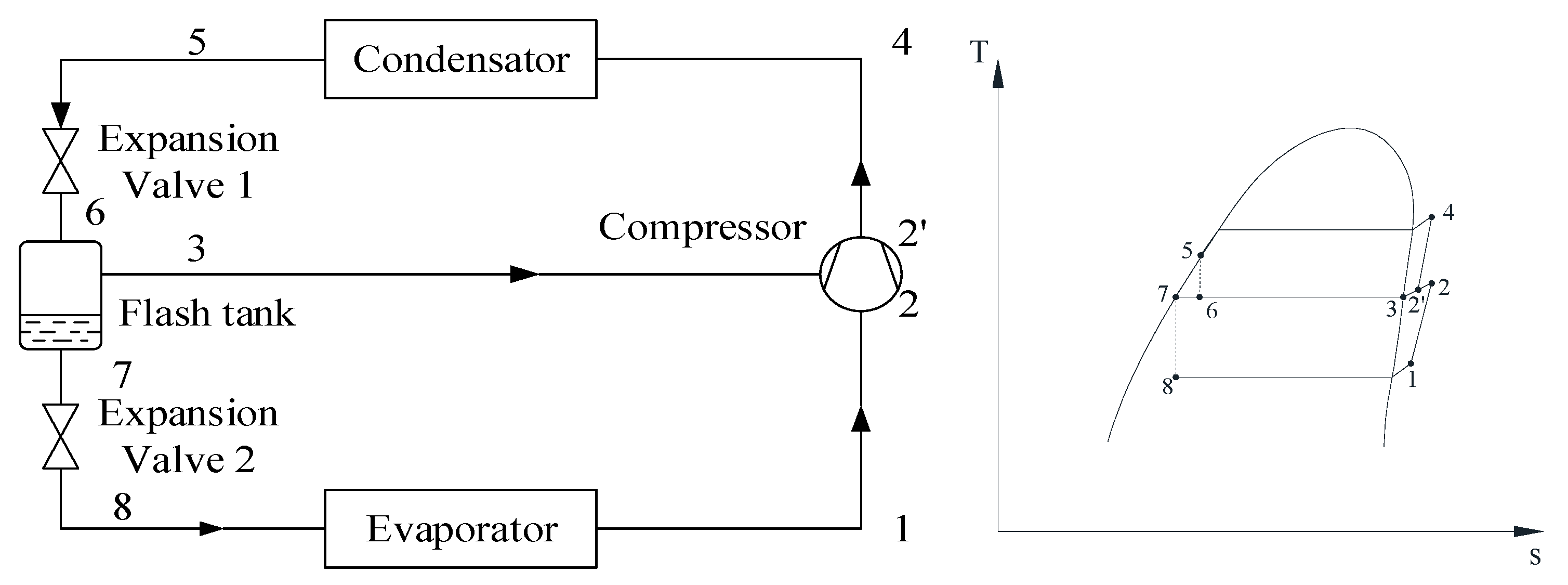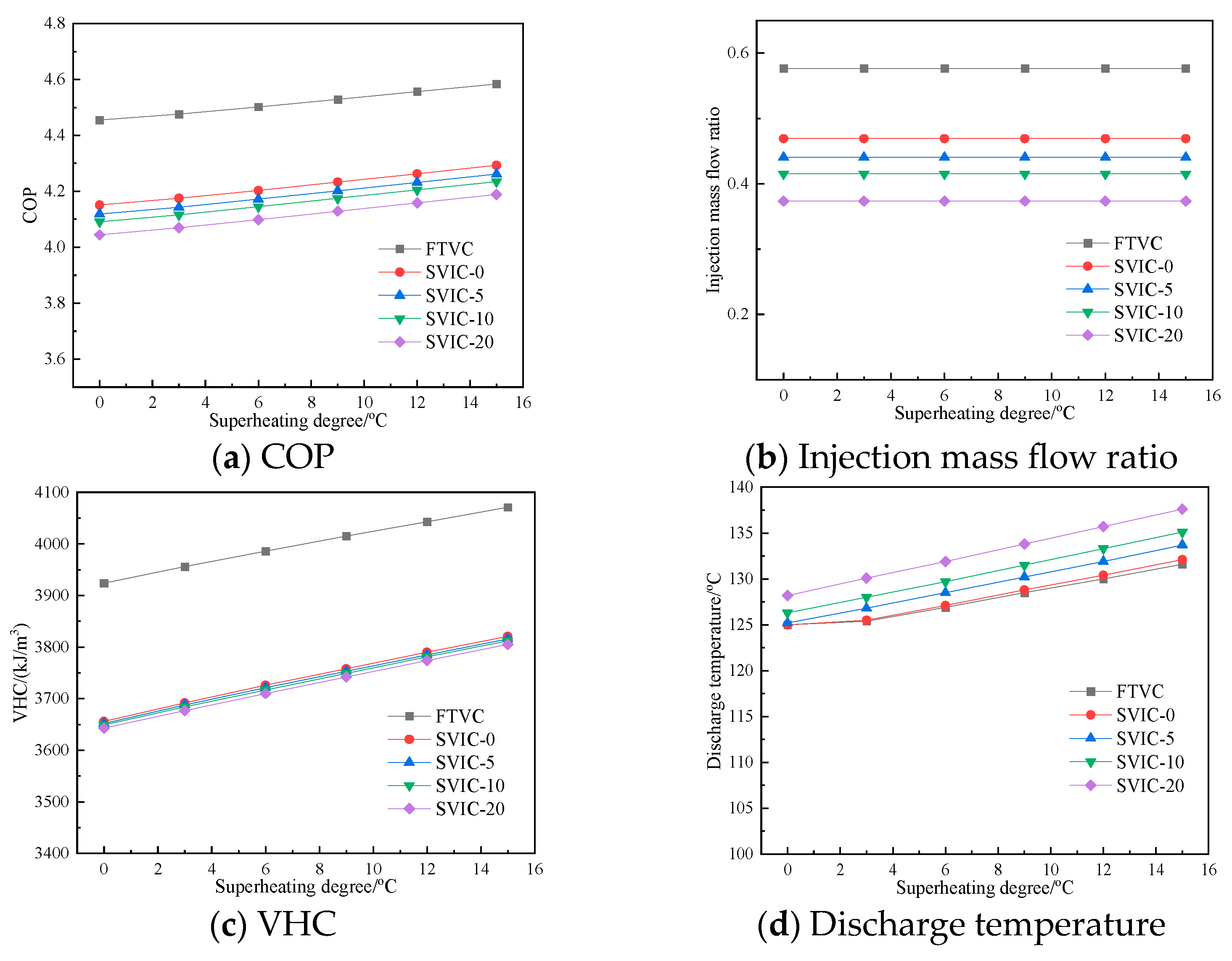Performance Comparison of High-Temperature Heat Pumps with Different Vapor Refrigerant Injection Techniques
Abstract
:1. Introduction
2. System Description
3. Model Establishment
3.1. Assumptions and Boundary Conditions
- (1)
- The working fluid in the heat pump system is steady state;
- (2)
- The heat loss and pressure loss in heat exchangers and pipelines are ignored;
- (3)
- The compressor efficiencies in heat pumps are constant;
- (4)
- The expansion valve process is considered isenthalpic.
3.2. Model Establishment
4. Results and Discussion
4.1. Performance Comparison under Different Evaporation Temperatures
4.2. Performance Comparison under Different Condensation Temperatures
4.3. Performance Comparison under Different Suction Superheat Degrees
4.4. Performance Comparison under Different Subcooling Degrees
4.5. Performance Comparison under Different Compressor Isentropic Efficiencies
5. Conclusions
Author Contributions
Funding
Data Availability Statement
Conflicts of Interest
Nomenclatures
| 1,2, …, 10 | thermodynamic state points |
| A | injection mass flow ratio |
| h | enthalpy, kJ/kg |
| mass flow rate, kg/s | |
| M | molecular mass, g/mol |
| P | pressure, kPa |
| Q | heat capacity, kW |
| RIP | relative injection pressure |
| t | temperature, °C |
| VHC | volumetric heating capacity, kJ/m3 |
| mechanical power, kW | |
| Abbreviations | |
| COP | coefficient of performance |
| FTVC | flash tank vapor injection cycle |
| GWP | global warming potential |
| HTHP | high-temperature heat pump |
| HTCHP | high-temperature cascade heat pump |
| LMTD | logarithmic mean temperature difference |
| NBP | normal boiling point |
| ODP | ozone depression potential |
| SG | safety grade |
| SVIC | sub-cooler vapor injection cycle |
| Subscripts | |
| c | compressor |
| cond | condensator |
| disch | discharge temperature |
| evap | evaporator |
| in | input |
| inj | injection |
| is | isentropic |
| out | output |
| sub | subcooling |
| sup | superheat |
| ref | refrigerant |
| th | throttle |
| Greek Symbols | |
| η | efficiency |
| v | specific volume, m3/kg |
References
- IEA. Net Zero by 2050-a Roadmap for the Global Energy Sector; IEA: Paris, France, 2021; Available online: https://www.iea.org/reports/net-zero-by-2050 (accessed on 12 December 2023).
- Yan, H.Z.; Zhang, C.; Shao, Z.; Kraft, M.; Wang, R.Z. The underestimated role of the heat pump in achieving china’s goal of carbon neutrality by 2060. Engineering 2023, 23, 13–18. [Google Scholar] [CrossRef]
- Jiang, J.T.; Hu, B.; Wang, R.Z.; Deng, N.; Cao, F.; Wang, C.C. A review and perspective on industry high-temperature heat pumps. Renew. Sust. Energ. Rev. 2022, 161, 112106. [Google Scholar] [CrossRef]
- Xue, J.; Guo, X.M.; Xue, L.P. Experimental study on performance of air-source heat pump system using refrigerant R32 with flash-tank vapor injection. Cryog. Supercond. 2018, 4, 88–91+96. (In Chinese) [Google Scholar] [CrossRef]
- Roh, C.W.; Kim, M.S. Effects of intermediate pressure on the heating performance of a heat pump system using R410A vapor-injection technique. Int. J. Refrig. 2011, 34, 1911–1921. [Google Scholar] [CrossRef]
- Roh, C.W.; Kim, M.S. Effect of vapor-injection technique on the performance of a cascade heat pump water heater. Int. J. Refrig. 2014, 38, 168–177. [Google Scholar] [CrossRef]
- Zhang, D.; Li, J.P.; Nan, J.H.; Wang, L.H. Thermal performance prediction and analysis on the economized vapor injection air-source heat pump in cold climate region of China. Sustain. Energy Techn. 2016, 18, 127–133. [Google Scholar] [CrossRef]
- Heo, J.Y.; Jeong, M.W.; Kim, Y.C. Effects of flash tank vapor injection on the heating performance of an inverter-driven heat pump for cold regions. Int. J. Refrig. 2010, 33, 848–855. [Google Scholar] [CrossRef]
- Heo, J.Y.; Jeong, M.W.; Baek, C.H.; Kim, Y.C. Comparison of the heating performance of air-source heat pumps using various types of refrigerant injection. Int. J. Refrig. 2011, 34, 444–453. [Google Scholar] [CrossRef]
- Mathison, M.M.; Braun, J.E.; Groll, E.A. Performance limit for economized cycles with continuous refrigerant injection. Int. J. Refrig. 2011, 34, 234–242. [Google Scholar] [CrossRef]
- Yang, M.H.; Wang, B.L.; Li, X.T.; Shi, W.X.; Zhang, L.P. Evaluation of two-phase suction, liquid injection and two-phase injection for decreasing the discharge temperature of the R32 scroll compressor. Int. J. Refrig. 2015, 59, 269–280. [Google Scholar] [CrossRef]
- Qi, H.J.; Liu, F.Y.; Yu, J.L. Performance analysis of a novel hybrid vapor injection cycle with subcooler and flash tank for air-source heat pumps. Int. J. Refrig. 2017, 74, 540–549. [Google Scholar] [CrossRef]
- Kim, D.W.; Jeon, Y.S.; Jang, D.S.; Kim, Y.C. Performance comparison among two-phase, liquid, and vapor injection heat pumps with a scroll compressor using R410A. Appl. Therm. Eng. 2018, 137, 193–202. [Google Scholar] [CrossRef]
- Arpagaus, C.; Bless, F.; Uhlmann, M.; Schiffmann, J.; Bertsch, S.S. High temperature heat pumps: Market overview, state of the art, research status, refrigerants, and application potentials. Energy 2018, 152, 985–1010. [Google Scholar] [CrossRef]
- Kontomaris, K. Zero-ODP, low-GWP, non-flammable working fluids for high temperature heat pumps. In Proceedings of the ASHRAE Annual Conference, Seattle, WA, USA, 1 July 2014; pp. 1–40. [Google Scholar]







| Working Fluid | Chemical Formula | Group | M [g/mol] | tcr [°C] | Pcr [bar] | NBP [°C] | GWP | ODP | SG |
|---|---|---|---|---|---|---|---|---|---|
| R245fa | CHF2CH2CF3 | HFC | 134.05 | 154 | 36.5 | 15.3 | 858 | 0 | B1 |
| Parameters | Reference Values | Boundary Conditions |
|---|---|---|
| Refrigerant mass flow rate ref/(kg/s) | 1 | - |
| Evaporation temperature te/°C | 55 | 40~80 |
| Superheat degree tsup/°C | 10 | 0~15 |
| Condensation temperature tc/°C | 125 | 100~130 |
| Subcooling degree tsub/°C | 5 | 0~15 |
| Injection mass flow ratio A | 0.3 | - |
| Relative injection pressure RIP | 1 | - |
| Injection superheat degree tsup,inj/°C | 5 | 0~20 |
| Compressor isentropic efficiency ηis | 0.72 | 0~0.9 |
Disclaimer/Publisher’s Note: The statements, opinions and data contained in all publications are solely those of the individual author(s) and contributor(s) and not of MDPI and/or the editor(s). MDPI and/or the editor(s) disclaim responsibility for any injury to people or property resulting from any ideas, methods, instructions or products referred to in the content. |
© 2024 by the authors. Licensee MDPI, Basel, Switzerland. This article is an open access article distributed under the terms and conditions of the Creative Commons Attribution (CC BY) license (https://creativecommons.org/licenses/by/4.0/).
Share and Cite
Yang, Y.; Wang, Y.; Xu, Z.; Xie, B.; Hu, Y.; Yu, J.; Chen, Y.; Zhang, T.; Lu, Z.; Gong, Y. Performance Comparison of High-Temperature Heat Pumps with Different Vapor Refrigerant Injection Techniques. Processes 2024, 12, 566. https://doi.org/10.3390/pr12030566
Yang Y, Wang Y, Xu Z, Xie B, Hu Y, Yu J, Chen Y, Zhang T, Lu Z, Gong Y. Performance Comparison of High-Temperature Heat Pumps with Different Vapor Refrigerant Injection Techniques. Processes. 2024; 12(3):566. https://doi.org/10.3390/pr12030566
Chicago/Turabian StyleYang, Yuqiang, Yu Wang, Zhaoyang Xu, Baojiang Xie, Yong Hu, Jiatao Yu, Yehong Chen, Ting Zhang, Zhenneng Lu, and Yulie Gong. 2024. "Performance Comparison of High-Temperature Heat Pumps with Different Vapor Refrigerant Injection Techniques" Processes 12, no. 3: 566. https://doi.org/10.3390/pr12030566
APA StyleYang, Y., Wang, Y., Xu, Z., Xie, B., Hu, Y., Yu, J., Chen, Y., Zhang, T., Lu, Z., & Gong, Y. (2024). Performance Comparison of High-Temperature Heat Pumps with Different Vapor Refrigerant Injection Techniques. Processes, 12(3), 566. https://doi.org/10.3390/pr12030566






